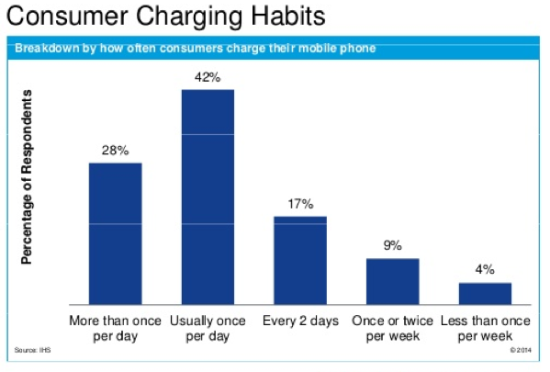by Lou Basenese
Summary
- With the most anticipated Apple event in history about to kick off, a specific feature, not a product, promises to be the most significant development.
- Rumors, backed by credible evidence in the form of a patent application suggest Apple's iWatch will offer wireless charging capabilities.
- Apple is uniquely positioned to bring about the tipping point for consumer awareness and in turn, mass adoption.
- Energous is the only pure play stock. It's novel RF approach makes it the potentially biggest winner of a wireless charging boom, sparked by Apple.
Forget about the long awaited launch of the iPhone 6. We could be at the doorstep of a much more significant development when Apple (NASDAQ:AAPL) unveils its latest round of products at today's big event.
You see, analysts also expect the company to unwrap its first wearable device, the iWatch. And wearables represent an up-and-coming industry in desperate need of a breakout product.
Despite attracting $1.4 billion in venture capital funding - and lofty expectations for device shipments stretching into the hundreds of millions by 2018 - a mere 1 million smartwatches sold in the second quarter, according to Strategy Analytics.
That compares to 295 million smartphones during the same period. (Can you say, pathetic?).
Market-leader Samsung (OTC:SSNLF) has already launched five smartwatch models. And yet, every last one of them has been a dud.
No wonder industry insiders are publicly "hoping that Apple can crack the missing [sales] code," as Reuters reports.
Whether Apple can officially jump-start the wearables market remains to be seen. We'll save that discussion for another day.
What I'm most interested in today is one of the rumored features of the iWatch. It promises to be the most disruptive of all developments. For the entire mobile market, not just wearables.
Don't Taser Tether Me, Bro!
One of the most annoying things about mobile devices is the requirement to be tethered to a cord every couple of hours to recharge. This becomes an extreme pain point for wearables.

I mean, who wants to have a watch that requires removal every couple hours?
It's no surprise then, Apple's spent years trying to figure out a way to cleverly charge a wearable device.
A patent filed in September 2009 (# 8193781) reveals the company experimented with a kinetic approach, whereby the motion of a person's arm swinging would power a tiny charging station within the device.
Reliable sources confirmed to The New York Times that Apple's also been experimenting with a solar-charging approach, by adding a photovoltaic layer to the screen.
In the end, it appears the company opted for a wireless charging method. And that, my friends, is the development everyone should be talking about.
A Cable-Free Future is Upon Us
Right before the closing bell on September 4, rumors started circulating that Apple's iWatch will include an inductive wireless charging solution.
Strong evidence exists to support the claims, too. Specifically, patent application # 20140241555, which was filed in early 2013 and just published on August 28.
In it, Apple describes coiled inductor wires with dual purposes. The NFC antenna, for instance, which is going to enable Apple's foray into mobile payments, could also be used for wireless charging, as needed.
Wireless charging has been gaining more and more attention because of the obvious need for it.
While mobile devices keep getting more and more powerful, advancements in battery technology have not been able to keep up.
"The gap is becoming larger and larger, so by 2020 the gap will be exponentially larger than it is today," according to Rahul Mangharam, an electrical engineering professor at the University of Pennsylvania.
That means much more frequent tethering to a power cord is coming. Or is it?
In recent months, Intel (NASDAQ:INTC) and Starbucks (NASDAQ:SBUX) made big announcements involving wireless charging initiatives.
On June 11, Intel teamed up with privately held, Witricity, to incorporate wireless charging capabilities into chip designs. Intel's goal is to have a completely wire-free laptop by 2016.
The very same day, Starbucks announced a national rollout of Duracell's Powermat wireless charging stations.
Both initiatives represent important steps towards a cable-free future. But Apple's the one company that can initiate a quantum leap forward.
We can all agree, Apple's in rarefied air when it comes to captivating and influencing consumers. Therefore, Apple's adoption of a wireless charging solution holds the potential to unlock pent up demand that consumers didn't even know existed. In a way Starbucks and Intel simply can't.
Confused? Let me explain…
A recent study by HIS found that two-thirds of consumers don't even have a clue that wireless charging capabilities exists.
However, once informed, a staggering 83% said they would be interested in wireless charging. They'd be willing to pay for the capabilities, too.
Bottom line: Apple's inclusion of a wireless charging solution in the iWatch promises to be the tipping point for consumer awareness and in turn, mass adoption.
Not just in the wearables market, but also in all manner of battery-powered devices. Think Nest Thermostats, GoPro (NASDAQ:GPRO) cameras, keyboards, tablets, LED lighting, video game controllers, medical devices, home security systems and sensors. The list goes on.
Later today, we'll hopefully find out which of the currently available wireless charging standards Apple's going to use.
Regardless of the choice, I'm convinced the biggest, long-term beneficiary of the development promises to be Energous Corp. (NASDAQ:WATT). I'll share more specifics why shortly. It relates to the company's novel approach (radio frequency instead of inductive). So stay tuned.
No comments:
Post a Comment